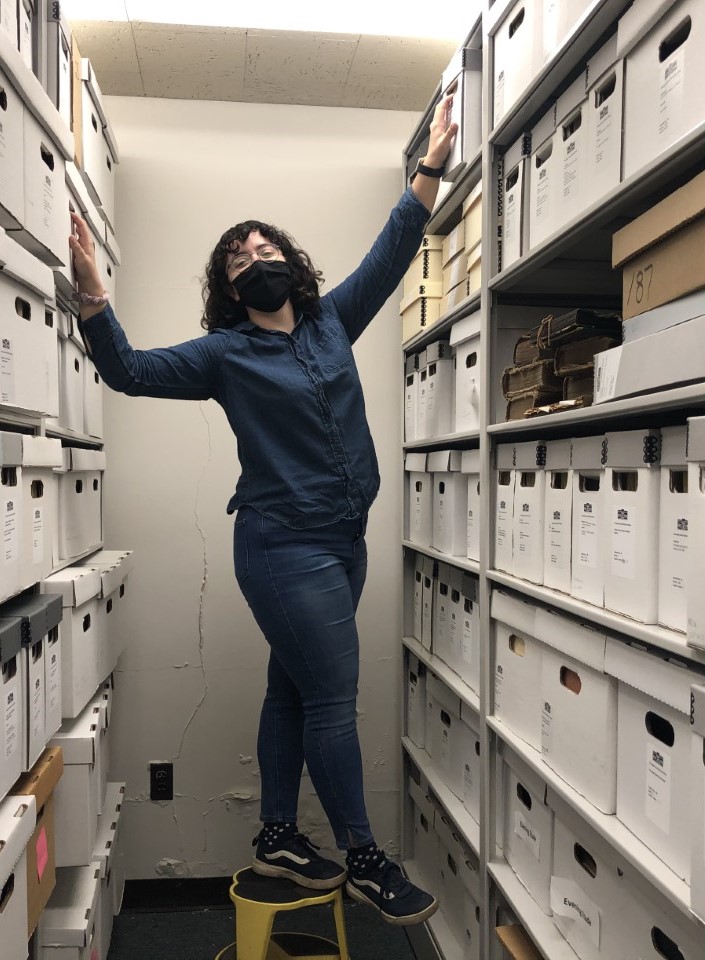 Hello! My name is Mary Pedraza, and I am the apprentice at the Champaign County Historical Archives (CCHA) of The Urbana Free Library. I am in my final semester at the School of Information Sciences at the University of Illinois. This semester, my apprenticeship has become an independent study in which I assign myself a project. So! I have decided to take on the huge task of rearranging our special collections storage space at the Library Annex.
Hello! My name is Mary Pedraza, and I am the apprentice at the Champaign County Historical Archives (CCHA) of The Urbana Free Library. I am in my final semester at the School of Information Sciences at the University of Illinois. This semester, my apprenticeship has become an independent study in which I assign myself a project. So! I have decided to take on the huge task of rearranging our special collections storage space at the Library Annex.
Many libraries and archives run out of storage space for their collections. The Archives supplements its reading room and finite storage within The Urbana Free Library with the former Tepper & Mann building located next to the Library. Originally a law office built in 1963, the Library Annex serves as an additional office and storage space for the Archives.
Like many archives in the world, CCHA has a small backlog of unprocessed collections. Some institutions often realize they do not even know what they have, within their unprocessed collections. Sometimes a cool collection is discovered that brings new discoveries and may rewrite history. [1] Often, as with the case of CCHA, we know what is there, but sadly have not fully addressed it for years. This may be due to understaffing, or different priorities push these collections to the side. However, with my project, I will create a well-documented plan to organize and maximize the efficiency of the storage available for our physical boxes.
Basic archives practices for collections storage recommend maintaining intellectual and physical control over your collections to ease access and discoverability. [2] While there are no basic standards for what order to keep collections, it has been suggested archives group collections together based on how researchers and patrons use them. [3] At CCHA, we mainly keep our special collections in the Library Annex while keeping our county records like Chancery Court cases, marriage licenses, birth and death records in the Archives' closed stacks. We keep all our microfilm together in the reading room, with the newspaper microfilm in one location, while the county records are in another. In collection management, keeping collections physically together is rudimentary and common sense, but it isn't easy to stick to across the board.
While the National Archives provides a records storage standards toolkit that their institutions follow [4] and the Society of American Archivists (SAA) provides their recommended standards [5], in the archival field, collections management regulations are defined and adhered to within each institution. This flexibility is important because no two archival collections are the same.
My project will have several phases, the first of which I have already completed. I began at the end of January by taking an existing location list of the Library Annex and seeing how accurate it is. From there, I spent several weeks identifying boxes that were listed but either in the wrong location or without a location, as well as identifying unlisted boxes by looking over old inventories of them. Some boxes have not been gone through since before I was born (1997!).
Now I am in the process of making a plan to physically place collections together, as well as place possible additions to existing collections together. I will also standardize and create new box labels for all collections (as accurate labeling is extremely important). And finally, make a workflow for future processing projects to be done once the collections are physically located.
I have two more months to this project, and by the end of it, we should see a whole new Library Annex.
- Mary Pedraza
Archives Apprentice
------------
[1] "Missing" Descartes Letter Discovered in Haverford Archives, Will Be Returned To French Owner;" "Discovery of Galileo’s long-lost letter shows he edited his heretical ideas to fool the Inquisition;" "A New Parchment Declaration of Independence Surfaces. Head-Scratching Ensues"
[2] Theodore R. Schellenberg, Modern Archives (Chicago: Univ. of Chicago Pr, 1956), 161-163.
[3] Raya Fidel, "User-Centered Indexing," Journal of the American Society for Information Science 45, no. 8 (1994): pp. 572-576
[4] National Archives, Records Storage Standards Toolkit
[5] Society of American Archivists, Standards Portal
